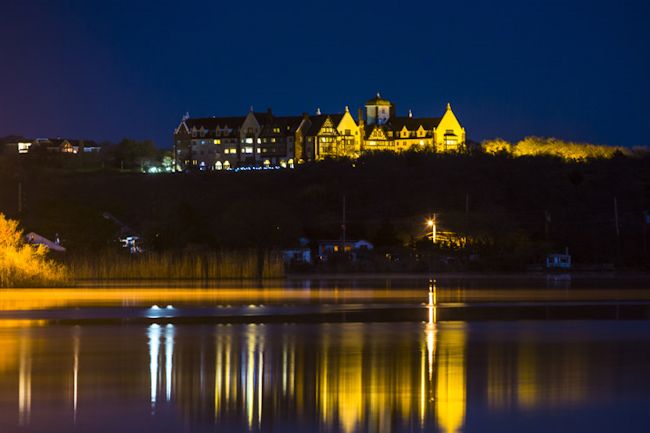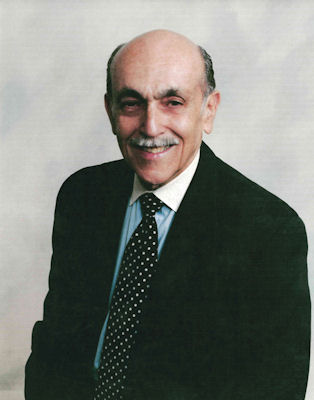
My Four Hotel Books; Availability as an Expert Witness
By Stanley Turkel, CMHS
1. Hotel History: The Montauk Manor, Montauk, Long Island, N.Y.*
The history of modern Montauk on eastern Long Island is intimately interwoven with the legendary real-estate developer Carl Graham Fisher. In 1925, Fisher purchased the entire peninsula of Montauk – over 10,000 acres in total for $2.5 million – to develop as a grand resort. Much of what makes up today’s Montauk – its roads, churches, downtown village, harbor area, golf course, and dozens of commercial buildings and homes, were built by Fisher during a whirlwind of development from 1926 to 1932.
Previously, Fisher created and developed:
▪ Miami Beach.
▪ Fisher Island.
▪ The Indianapolis Speedway and the Indianapolis 500 which is still regarded by many as the world’s premier automobile-racing event.
▪ The Lincoln and Dixie highways. Fisher raised private funds for these two road projects, which were forerunners of the U.S. Interstate Highway System.
Despite Fisher’s extraordinary accomplishments, however, no beach, no highway, no hotels, and no race track is named for Carl Graham Fisher. Only Fisher Island bears his name. Fisher bought the island in 1919 from Dana A. Dorsey, a prominent black businessman in Miami who had given up on an effort to build a resort for African-Americans (who were barred from segregated Miami’s beaches). The island itself was created in 1905 when the federal government sliced off the southern tip of Miami Beach to make a shipping channel from Miami to the Atlantic Ocean.
Always restless, with boundless energy, Fisher no sooner established Miami Beach than he started looking for his next great challenge. He found it in Long Island’s Montauk, three times the size of Miami Beach, almost entirely undeveloped. It was to be the culmination of his life’s work. He estimated it would take $7,000,000 to develop it. “Miami in the Winter, Montauk in the Summer”, was Fisher’s slogan. He would provide the elite who had flocked to his Miami Beach, with a comparably exclusive summer resort just hours from the social centers of New York City and Newport, Rhode Island.
Montauk’s 1932 promotional brochure emphasized the notion of social exclusivity: “Now Montauk Beach, through the vision and resources of a group of distinguished builders, is being transformed into America’s finest out-of-door center, where the real aristocrats of modern America may find new health, new relaxation, new ways to play amid luxurious surroundings.”
By the time Fisher arrived, Montauk was already well known among connoisseurs, as a first- class fishing and hunting retreat. Ever since the late 1800s, well-heeled hunters and anglers had gone “on Montauk” for extended expeditions. What they found was a beautiful, rustic outpost nearly untouched by the modern era. Teeming with geese, duck, turkey, fox, rabbit, and deer, Montauk was a hunter’s heaven. Inshore and offshore, no finer fishing could be found on the east coast. As a first-class resort – or a resort of any kind – it left nearly everything to be desired. On the shore on Fort Pond Bay, near the current railroad station, the village of Montauk crowded the water with fishing shacks, warehouses, commercial docks, and piers. In general there was no electricity, no running water, no indoor plumbing, and little in the way of creature comforts anywhere in town.
Fisher was faced with the formidable task of transforming those 10,000 virgin acres into a world- class resort. Within weeks of his purchase, a crew of some 800 men were working around the clock, clearing roads, installing sewers, power lines and laying the infrastructure for a large scale, modern village. On June 1, 1927 the palatial Montauk Manor was opened and its 178 modern guest rooms were quickly filled with summer vacationers.
It was designed by the famous architects Schultze and Weaver, the firm responsible for the Breakers in Palm Beach, the Biltmore in Los Angeles, and the Pierre, Sherry Netherland and the Waldorf-Astoria in New York City.
The manor’s guests could choose from a variety of daily activities. An oceanfront bathing pavilion, complete with outdoor pool and 1,600 feet of boardwalk along the beach, was constructed on the site of the current Surf Club. Eighteen quality holes of golf could be played at what is now Montauk Downs. Tennis players could choose from twelve outdoor clay courts near the Manor, or six indoor courts. For polo enthusiasts, playing fields complete with paddocks, stables, and herds of ponies were maintained at the nearby Deep Hollow Ranch. The horsy set could ride on established trails and the beach, and even run with the hounds in a traditional English-style fox hunt. Add to all that recreation the nearly unlimited fishing and hunting Montauk always provided, and it’s easy to see how a visitor’s day was filled. Established in his headquarters suite atop the new six-story Montauk Improvement Building – at the time the tallest building on Long Island– Fisher watched his vision and plans become a reality.
Perhaps Fisher’s most ambitious piece of engineering was the reconfiguration of present day Lake Montauk. It was, until 1927, a true lake – fresh water, land locked, and as such of no use to Fisher. He needed a yacht club, with deep water berths capable of docking the grand vessels of the Astors, Vanderbilts, and Whitneys. Unfortunately, Montauk’s only available anchorage, at Fort Pond Bay, was unsuitable- it was unprotected and subject to devastating storms and high tides. Unperturbed, Fisher came up with a grand solution: he blasted open a channel from Block Island Sound to connect Lake Montauk to the open sea. Once done, he dredged roughly half the lake to a depth of 12 feet and established the Montauk Lake Club, on Star Island. It remains in operation today, and is capable of docking ocean-going vessels up to 150 feet in length.
In the 1920s Montauk was a cosmopolitan resort, a Monte Carlo on the Atlantic that attracted the world’s elite. Montauk Manor was the most luxurious hotel on Long Island, a favorite of the New York/Newport crowds. Indeed, the Manor’s popularity supported direct steamer service to Manhattan. Each night of the summer season, lines of fancy touring cars and limos would disgorge scores of blue bloods and society swells who were bound for a champagne dinner and secret midnight rendezvous within the Manor’s comfortable rooms. The Star Island Casino, next to the yacht club, was jumping every night, with fine food, excellent wine and the ever-present sound of money hitting the tables. It was there that the then-mayor of New York City, Jimmy Walker, was nearly arrested during an infrequent raid by the local authorities. For the first few years, Fisher’s dream city of Montauk was a genuine and profitable reality.
Fisher had planned for everything, everything that is, except weather and the Great Depression. On September 17, 1927, a strong hurricane hit Miami Beach. Although the actual damage was not as severe as reported in media accounts, the news was sufficient to warn off travelers and the 1927- 28 tourist season was a bust. Then in 1929 the bottom fell out of the stock market and real estate values began a dizzying fall. Since much of Fisher’s wealth was based on real estate, his fortune began to crumble. Within the year, his empire had lost a third of its value, and the bankers who held his notes began to become nervous.
As his credit began to thin, Fisher sold his holdings – the Indianapolis Speedway, Miami Beach hotels, homes, yachts, land- that is, nearly everything that could be liquidated. Stretched beyond even his formidable means, his empire collapsed into bankruptcy in 1932. Three years later, Fisher declared personal bankruptcy. When he died in 1939, his personal estate amounted to just $52,198.
Although Montauk itself had a few good years in the 1930s and 40s, Fisher’s dream of another Miami Beach was buried along with him. Without his considerable talent and salesmanship, Montauk was left with the imposing infrastructure of a grand resort, but with few of the details completed. Within years of its zenith, much of Fisher’s Montauk fell into decay and ultimately abandonment. By the 1950s his office building stood empty, Montauk Manor was a brooding wreck, and his grand boulevards ran off to nowhere. Montauk’s caretakers were left with no other choice but to fill in the gaps as best they could, the result being a somewhat uneven resort community.
Montauk today is an amalgam of Fisher’s original vision of a getaway for the rich and the reality of an affordable vacation village. Admittedly, Montauk now has over 3,000 quality hotel rooms, some 50 restaurants 1,000 deep-water boat slips, a world-class golf course, and some of the most beautiful ocean and bay beaches in the world. Even some of Fisher’s original projects have been resurrected in the past few years. For example, the Montauk Manor and Fisher’s six-story headquarters building on the green are now deluxe condominiums. The yacht club is under new management, with restoration of its remaining Fisher sections in full swing. The golf course is better than ever, as is Montauk Downs.
The Manor contains 140 condominium apartments, a magnificent indoor and outdoor swimming pool, a private health club and three tennis courts. Complete hotel services are available and all residents enjoy the deluxe service which for so long had been the trademark of Montauk Manor. The apartments range in size from studio, to deluxe three bedrooms, many residences enjoying the benefit of a private studio, terrace or balcony. There are large variety of layouts, and all but the studio units are available as simplex or duplex depending upon personal preference.
The Montauk Manor was added to the U.S. National Register of Historic Places in 1984.
*excerpted from my book “Great American Hoteliers: Pioneers of the Hotel Industry” AuthorHouse 2009.
2. Four Hotel Books
If you visit my website (www.stanleyturkel.com) and click on the book title, you will be connected to my publisher, AuthorHouse where you can order a dust jacket hardcover, softcover or an e-book of the following books:
• Great American Hoteliers: Pioneers of the Hotel Industry (2009)
• Built To Last: 100+ Year-Old Hotels in New York (2011)
• Built To Last: 100+Year-Old Hotels East of the Mississippi (2013)
• Hotel Mavens: Lucius M. Boomer, George C. Boldt and Oscar of the Waldorf (2014)
3. Availability as an Expert Witness
Since 1992, I have served as an expert consultant and/or witness in many hotel-related lawsuits. Those cases involved the following subjects: 1) hurricane damage and business interruption claims 2) wrongful deaths 3) fire and other catastrophes 4) slip and fall accidents 5) franchisor/franchisee disputes 6) management contract disagreements 7) carbon monoxide poisoning, etc.
A knowledgeable hotel expert can provide an attorney with a thorough understanding of hotel industry standards and practice, compelling testimony, thoughtful report writing and indispensable litigation support assistance.


